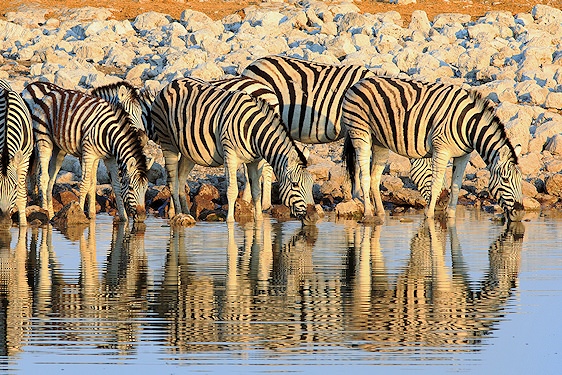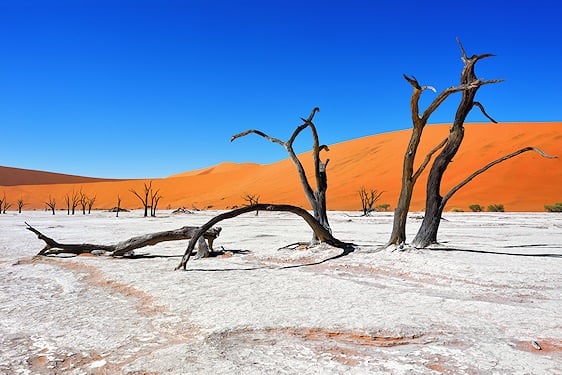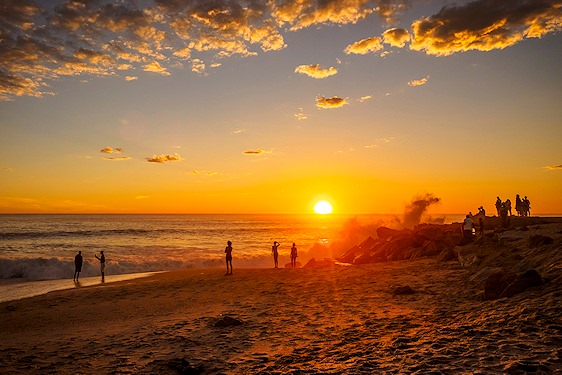Namibia Travel Destinations and Vacations
Help Me Plan- Home
- >
- African Travel
- >
- Namibia
Namibia Destination Guide
Planning a trip to Namibia? This guide covers everything you need — from travel and timing to safety, health, and safari tips — to explore one of Africa’s most diverse destinations with confidence.
Getting to Namibia
From Johannesburg or Cape Town, flights to Windhoek (the capital and gateway to safari areas) take about two hours. Travelers can also fly to Walvis Bay to access the coast and Swakopmund.
Weather & Best Time to Visit
Namibia proudly bills itself as one of the sunniest countries on Earth — averaging about 300 sunny days a year. With low humidity and semi-arid conditions (annual rainfall roughly 270 mm / 10.6 in), it’s generally hot and dry.
The dry season (May–Oct) brings cooler days and crisp nights; wildlife clusters at scarce waterholes, making Etosha and other reserves prime for game viewing. The rainy season (Nov–Apr) is hotter but turns usually arid plains green; in exceptional years, Sossusvlei can even hold water.
Along the Atlantic, the cold Benguela Current keeps the coast cool and foggy (think the Skeleton Coast). Even in midsummer, sea temperatures rarely exceed ~19 °C (66 °F), and coastal air temps run far cooler than inland.
Visa Information
As of 1 Apr 2025, Namibia ended visa-free entry for 31+ countries (e.g., US/UK/EU) and now requires e-visa or visa on arrival depending on nationality. Official Namibia Visa Information and Application Process.
Medical Considerations
Malaria occurs mainly in northern and northeastern Namibia, including Etosha (seasonally), parts of Damaraland, and the Zambezi Region (formerly Caprivi). The coast (Skeleton Coast, Swakopmund, Walvis Bay, Lüderitz) and the south (Sossusvlei, Fish River Canyon) are generally malaria-free. Consult your doctor about antimalarials and carry repellent. Ensure routine vaccinations are up to date.
Safety
Namibia is generally safe, though petty crime can occur in cities like Windhoek and Swakopmund — keep valuables secure. On safari, never feed or approach wild animals.
Traveling Around
Exploring Namibia often involves long drives on well-maintained gravel roads, so a 4x4 is preferred for remote regions. Domestic flights connect major areas like Etosha and Sossusvlei. When driving, carry extra fuel and water in the desert.
Top Travel Destinations in Namibia
Namibia’s top destinations include Sossusvlei in the southwest and Etosha National Park in the north — places of endless horizons and otherworldly beauty.
Etosha is Namibia’s signature safari destination with exceptional photography in a unique, pan-dotted landscape.
Feel blissfully remote amid magnificent desert scenery with towering red dunes and star-studded skies.
With its German heritage, Namibia’s favorite seaside town blends adventure activities with bracing ocean air.
Namibia Vacation Options & Travel Tips
Namibian vacations offer excellent value and uniquely varied safari experiences.

Tours, Safaris & Honeymoons
Browse our thoughtfully crafted safari tours.

Tailor-Made Vacation Packages
Customize any tour or build from scratch.

Travel Tips & Advice
Essential info for visiting Southern Africa.
Other Recommended Travel Destinations in Namibia
Beyond the headline sights, Namibia offers dramatic canyons, remote deserts, and unique cultural regions worth exploring.
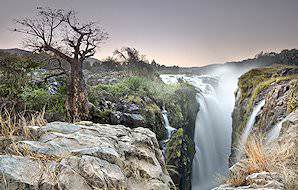
Zambezi Region (Caprivi)
A lush wetland corridor of rivers and wildlife, dotted with intimate lodges and ideal for boat and mokoro safaris.
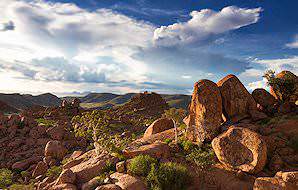
Damaraland
Home to Twyfelfontein rock engravings, Brandberg Massif, and desert-adapted elephant and rhino.
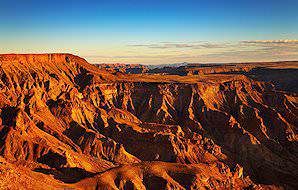
Fish River Canyon
One of the world’s largest canyons, with dramatic vistas, multi-day hikes, and striking sunsets.
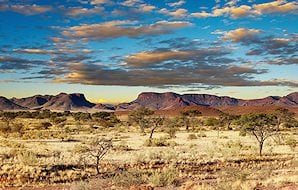
Kalahari
Rolling red dunes, star-filled skies, and wildlife like oryx and meerkats offer a softer desert experience.
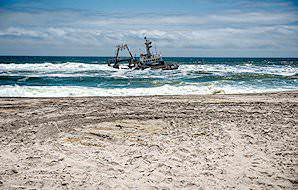
Skeleton Coast
A haunting meeting of dunes and Atlantic surf, scattered with shipwrecks and desert-adapted wildlife.
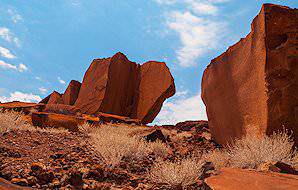
Twyfelfontein
UNESCO World Heritage site with more than 2,500 ancient rock engravings dating back thousands of years.
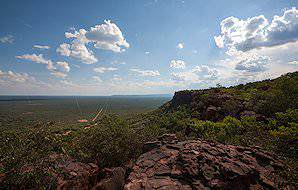
Waterberg Plateau Park
A dramatic sandstone plateau that protects rare species and supports black rhino conservation programs.
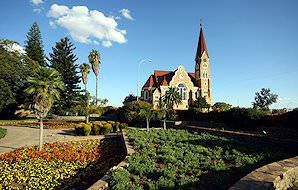
Windhoek
The capital city with German colonial architecture, markets, and access to Namibia’s main safari circuits.
Namibia Travel Video & Facts
Discover how much this uniquely Southern African country offers, even for seasoned travelers.
Namibia is an arid, sparsely populated country between the Kalahari Desert and the South Atlantic. It offers striking cultural diversity and superb wildlife reserves — a photographer’s dream of wild seascapes, rugged mountains, lonely deserts, and colonial-era towns.
Discover the other-worldliness of the Namib Desert
The world’s oldest desert holds many tales, secrets, and beautiful scenes — each unlike the other. From stories of underground aquifers and thousand-year-old welwitschia plants to desert-adapted elephants, ancient rock art, and relics of bygone eras.
Where the sands meet the Atlantic’s rolling waves, adventure awaits: towering dunes, 4x4 tracks, shipwrecks, quad-biking over the sands, and nightly stargazing.
Explore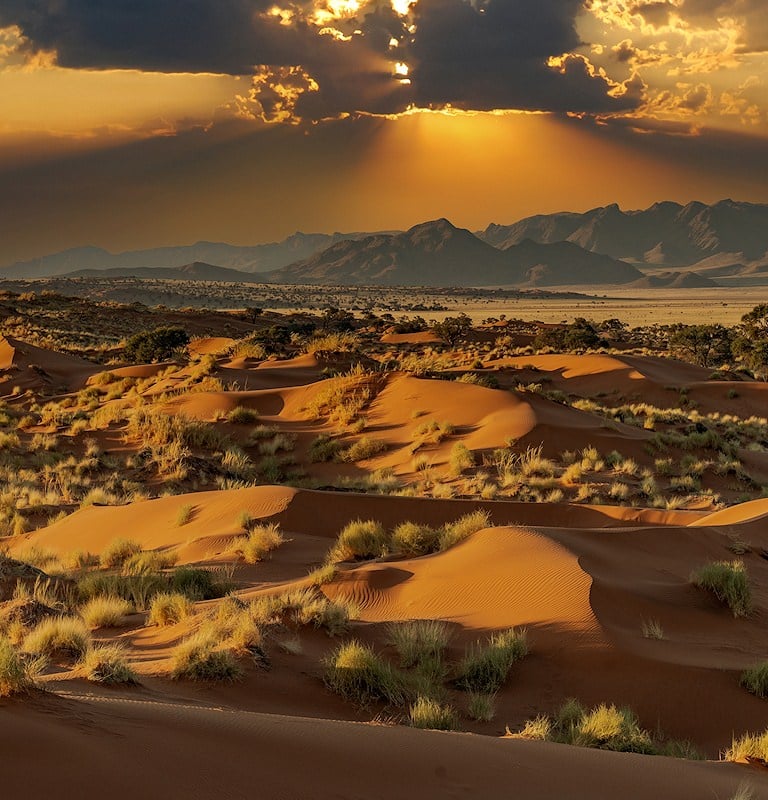
Foods to Try in Namibia
Quality produce from sea and land, prepared with African and German influences.
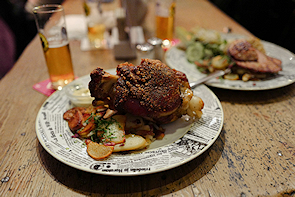
German Cuisine
Due to German colonization beginning in 1884, strong German influences remain in the cuisine. Brötchen (bread rolls), frankfurters, sauerkraut, and beer are staples.
Seafood
Kabeljou (cob), kingklip, and sole are favorites. Swakopmund is known for oysters, and Lüderitz for crayfish/rock lobster.
Beef
Much of Namibia’s cattle is free-range, yielding flavorful, relatively lean cuts — widely served as quality steaks.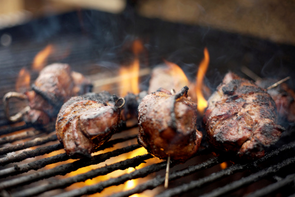
Game Meat
With access to gemsbok and springbok, game is popular — commonly served as biltong, steak, goulash, kebabs, or in a potjie.Namibia Travel FAQ
Generally, yes. Roads are mostly in good condition, but distances are long and many routes are gravel. Reduce speed, avoid night driving, and carry extra water. A 4×4 is recommended for remote desert areas and two spare tires are sensible.
Coverage is reliable in Windhoek and, to a lesser extent, Swakopmund. In remote areas like Etosha and Sossusvlei, service can be limited or absent. Many lodges offer Wi-Fi in common areas; consider a local SIM or eSIM (e.g., MTC) for broader coverage.
Namibia is a year-round destination. Summer (roughly Nov–Apr) can be hot, but afternoon rains from about December may moderate temperatures in places. Plan activities for early morning and late afternoon; most accommodations have air conditioning or fans.
Not fully. Cape buffalo do not occur in Etosha National Park, but black rhino, lion, elephant, and leopard are present in healthy numbers. For the full Big Five, many travelers combine Namibia with Botswana or South Africa.
Yes, but distances are vast. Main crossings include Vioolsdrift/Noordoewer on the N7/B1 corridor. If your time is limited, flying into Windhoek and exploring from there is usually more practical. Ensure rental paperwork allows cross-border travel if driving.
It depends on budget, comfort, and time. Charters save long drive times and offer spectacular aerial views, but cost more. Overland travel is more economical and scenic at ground level. Many itineraries mix both for the best balance.
Often, yes. Prices are in Namibian dollars (NAD), pegged 1:1 to the South African rand (ZAR). Strong infrastructure and a wide range of accommodations add value. Credit cards are widely accepted in towns; carry some cash for remote areas.
The Zambezi Region (formerly Caprivi) offers wetland safaris along major rivers; Damaraland features desert-adapted wildlife (including elephant and black rhino). Wildlife densities vary by area, but the settings are unique and rewarding.
About 81,000 km² (31,000 sq mi). It stretches along the Atlantic coast and includes famous dune fields around Sossusvlei in the Namib-Naukluft National Park.
The cold Benguela Current keeps Atlantic waters chilly and seas can be rough. Swimming is limited, but coastal activities—like kayaking with seals, boat trips, and fishing—are popular with reputable operators and suitable conditions.
Recommended Attractions
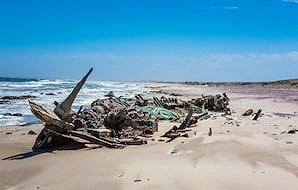
Skeleton Coast
The Skeleton Coast offers a ghostly experience. For centuries, ships met their end along this fog-riddled shoreline; few wrecks remain intact thanks to pounding surf and sand-blasting winds.
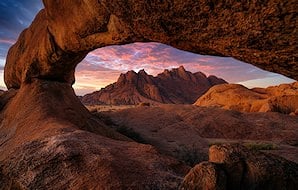
Spitzkoppe
A dramatic group of granite outcrops between Swakopmund and Usakos; the highest outcrop rises to about 1,728 m above sea level. The area features San rock art, hiking, and iconic photo spots.
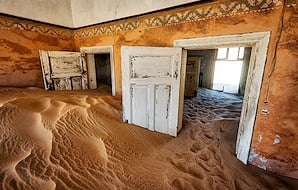
Kolmanskop
Namibia’s most famous ghost town near Lüderitz. Born of a 1908 diamond rush, it declined after World War I and was abandoned about 40 years later — now slowly reclaimed by the desert.
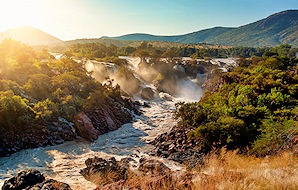
Epupa Falls
On the Kunene River in Kaokoland, “Epupa” (Herero for “the mist created by falling water”) offers hiking, baobab-studded scenery, and some swimmable pools — always check for crocodiles first.
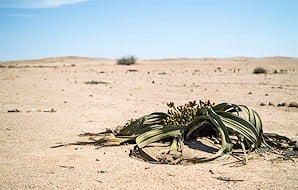
Welwitschia Plains
Between the Swakop and Khan rivers lies the largest concentration of welwitschia plants in Namibia — some believed to be nearly 2,000 years old.
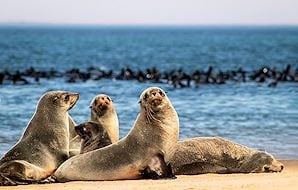
Cape Cross
Named for the padrão erected by Portuguese navigator Diogo Cão in 1486, the reserve now protects one of the world’s largest Cape fur seal colonies — seasonally exceeding 200,000 individuals.
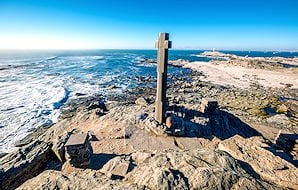
Diaz Point
At Lüderitz, a replica cross marks where Bartolomeu Dias erected a padrão on 25 July 1488. The original is lost to time; the replica was unveiled on the 500th anniversary in 1988.
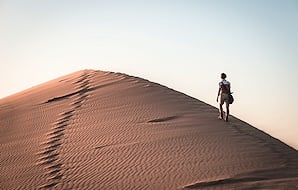
Dune 7
About 7 km east of Walvis Bay, Dune 7 is one of Namibia’s highest dunes and a focus for dune-boarding, quad-biking, and “summit” hikes.
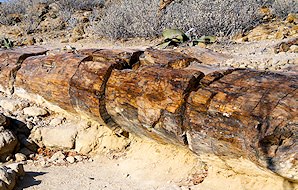
Petrified Forest
About 50 km west of Khorixas, enormous fossilized trunks — often dated to ~280 million years — lie where ancient floods carried and buried them in sediments.
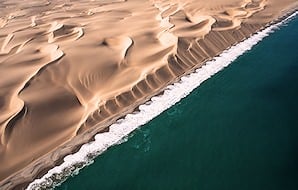
Sandwich Harbor
A coastal lagoon 55 km south of Walvis Bay within Namib-Naukluft National Park — part of the Namib Sand Sea. No fixed roads; sand tracks shift with tides and winds.
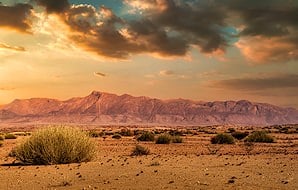
Brandberg
Brandberg (“burning mountain”) rises within Damaraland and includes Namibia’s highest peak, Königstein (2,606 m). The massif glows red at sunset.
Popular Activities
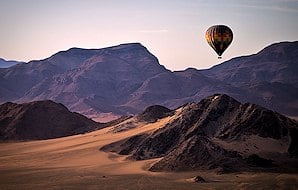
Ballooning
Ballooning over Namibia’s wilderness typically starts pre-dawn, with sunrise views and about an hour in the air, followed by a champagne breakfast. Expect ~3.5 hours total.
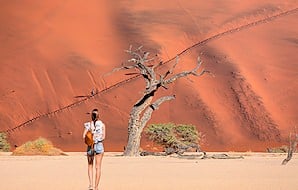
Dune Adventures
From dune hikes and sand-boarding to quad-biking, the Namib’s sea of sand is a natural playground.
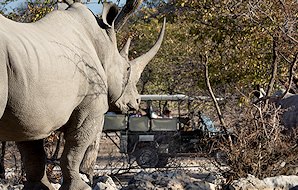
Game Drives
At lodges and camps across Namibia, daily game drives anchor your safari — with chances to see desert-adapted black rhino and black-faced impala.
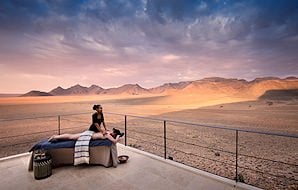
Spa Treatments
Many lodges offer treatments ranging from massages to facials and mani-pedis — either in dedicated spas or in-suite on private decks.
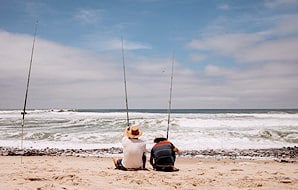
Fishing
The Atlantic coast offers rich surf and boat fishing (Walvis Bay, Swakopmund, Henties Bay). Northern rivers host freshwater species like the feisty tigerfish.
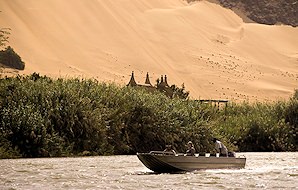
Cruises
Short cruises from Swakopmund and Walvis Bay focus on marine life (dolphins, whales, seals) and memorable Atlantic sunsets.
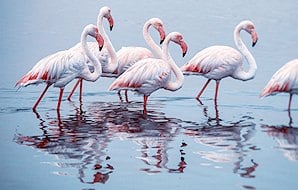
Bird Watching
Namibia lists ~650 species across diverse habitats — from coastal lagoons like Sandwich Harbor to Etosha’s waterholes during the dry winter months.
The People
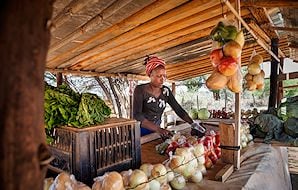
Ovambo
Despite its size, Namibia has one of the lowest population densities in the world. Around half of Namibians are Ovambo — descendants of Bantu-speaking peoples who migrated south in the early first millennium.
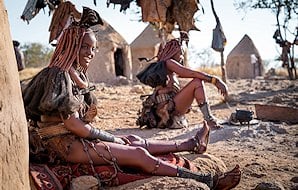
Other Major Population Groups
Other groups include the Kavango, Herero, Damara, Nama, San, and white Namibians (primarily Afrikaners and Germans), reflecting a diverse cultural mosaic.
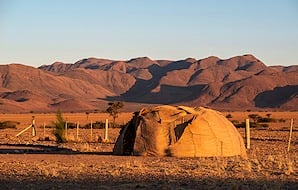
The Nama
The Nama — a Khoikhoi subgroup — preserve click-language traditions. A smaller San population also continues hunter-gatherer lifeways in parts of northern and eastern Namibia.
Geography
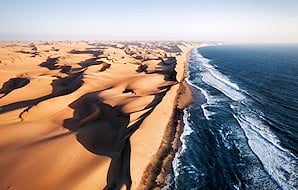
Coastal Plain and Central Plateau
Namibia’s narrow coastal plain runs inland 80–120 km to a rugged escarpment. With average rainfall of ~10 mm at the coast and ~150 mm along the desert’s eastern edge, it’s among the driest regions in sub-Saharan Africa.
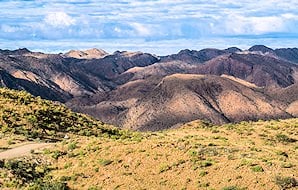
Escarpment
Part of Southern Africa’s Great Escarpment, it runs from the Kunene River southward. The central highlands’ dissected hills are known as the Khomas Hochland.
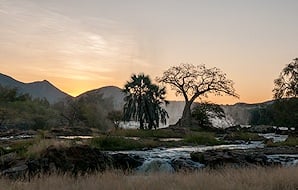
Inland Plateau
East of the escarpment lies a vast plateau of plains, low mountains, and inselbergs. Farther east, longitudinal Kalahari dunes prevail. In the far northeast, the Zambezi Region is a lattice of rivers, channels, and woodlands unlike anywhere else in Namibia.

